Glasgow Gorbals
Notoriously poor slum in the centre of Glasgow that has now been knocked down. Remains a byword for poverty.
The Forgotten Gorbals - from Picture Post - 31st January 1948
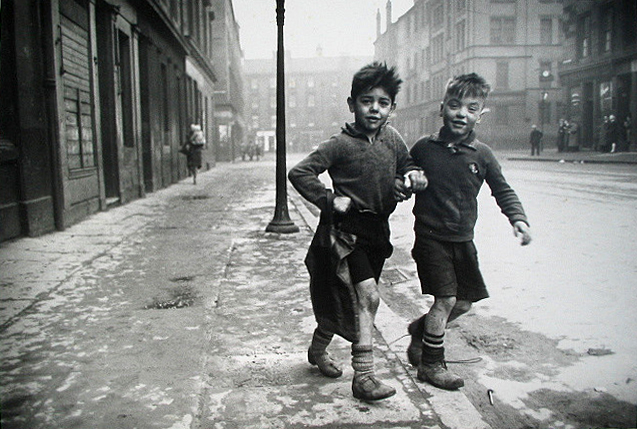
Book and ballet brand it an evil quarter of Glasgow. It is indeed. Not because of the people in it. But because of the way they must live. It is high time change were made.
The air of calm that covers a multitude of horrors. Nearly 40,000 people live in the Gorbals. they live for, six eight to a room, often thirty to a lavatory, forty to a tap. they live in Britain's most abandoned slum.
At first sight, of an early morning, the Gorbals looks like any other poor area. Its flat wide streets are lined with flat-faced tenements. There is a pub on every comer and an undertaker's (open day and night) in almost every other block. The walls are covered with chalk messages: Love God, Vote for McShane, Kilroy was Here, Irish Border Must Go, and (fading now) Victory. Cats are every-where; and for good reason.
It is not until you get inside the tenements that you realise the Gorbals isno ordinary poor place. It is in fact an area that provides a very special version of the slum problem.
In its beginnings, the problem was one of immigration. A century ago, thousands of poor labourers began to arrive in Glasgow. They came to work on the new-fangled railways and the docks of the Clyde.
They came for higher wages, for fuller plates, for what they conceived to be a better way of life than was possible in starving Erin and the wasted Scottish Highlands. A big proportion packed themselves into 252 acres just over the Clyde south from the city centre, in the area known as the Gorbals. Till then the Gorbals had been 'A Good Address,' a place for successful lawyers, doctors, merchants to retire to. But now the speculators built tenemen
ts over the gardens and the orchards. They built them quickly and cheaply, to house folk whose standards were far lower than those prevailing in the Lowlands. And there the descendants of those folk, and the thousands of newcomers who have joined them, live today in poverty, squalor, and in the hope that things will be better in the afterlife.
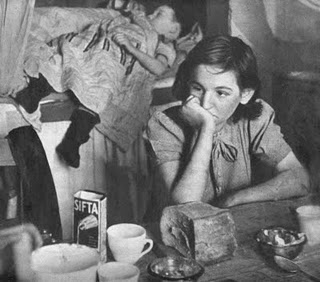
(picture) Mary is sixteen. She works in a Bakery. she has the the fancies and foibles natural to a girl her age. she dreams of nice clothes, hamdsome suitors, happy times. But already her life is coloured by her surroundings. already futility and frustration stretch ahead. Already her dreams re losing their battle against reality.
North of the Gorbals are the black rat-ridden banks of the Clyde. South is the railway jungle that spreads out from the big Goods and Mineral Depot on Pollokshaws Road. The western end of the ward has the handsome classical terraces of Abbotsford Place and Warwick Street. The eastern end is bounded by the lowering mid-Victorian tenements
of Lawmoor Street. Within these bounds live some 40,000 shockingly-housed people.
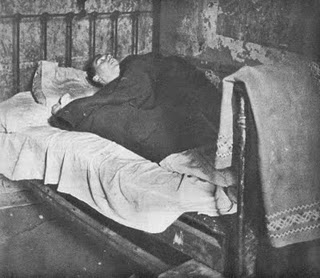
(picture) Out in the street is a fading chalk scrawl: "Welcome Home, John" And here lies John under his army greatcoat. It is 11am. the rest of the family are long gome - his brothers to school, his 16 year old sister to work. In a thousand rooms, no bigger than this, some Gorbals folk sleep four to a bed.
The Gorbals has no large industries, and few small ones, where its residents may find work.
Some of the local girls have jobs at the 'hair factory,' the mattress-making establishment in Ballater Street. But most folk must go elsewhere to make a living. The ward is simply a vast lodging-house.
As a lodging-house, the Gorbals could hardly be worse. In it, people live huddled together 281 to the acre. They live in apartments that are mostly small, dark and dirty. They live five and six in a single room that is part of some great slattern of a tenement, with seven or eight people in the room next door, and maybe eight or ten in the rooms above and below. The windows are often patched with cardboard. The stairs are narrow, dark at all times and befouled not only with mud and rain. Commonly there is one lavatory for thirty people, and that with the door off.
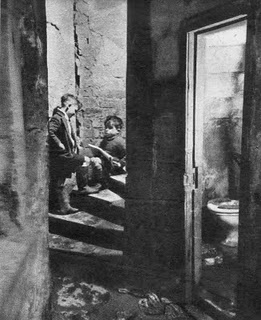
Rents are low. The average is rather less than ten shillings a week for a room, or £4 for an eight-roomed house. But in some parts, particularly in the handsome westward section, it is common to find a single tenant will lease a whole house cheap and then sublet to other tenants, room by room, till even the kitchen and the bathroom have a family living in them. This section around Warwick Street was a respectable professional-class neighbourhood till only twenty years ago. Nowadays its facades hide some of the worst horrors in the Gorbals. It is known as 'Chinatown' or “Burma”, because of the many Orientals—Indians mostly – who live there. Some investigators declare that sub letting racketeers may make nearly £2,000 a year from a single house hereabouts. But over most of the Gorbals, tenants pay the low 1914 rent, plus 40 per cent, for repairs, if they ever get done.
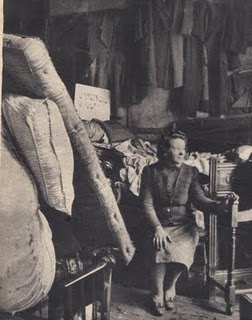
(picture) Mrs Lundy of Bedford Street, autctions bedding, crockery, clothes, The notice says "Goods not claimed in 7 days after first deposit will be sold"
Low rent is one reason why people stay in the Gorbals. Another reason may be the liking an Irishman has for an Irishman's company. And anyway, a man seeking to move now is lucky if he can find a place to go. Once the area had a large immigrant Jewish population, and the district round Gorbals Cross was called 'Little Jerusalem.' But many Jews left as their economic condition improved and nowadays, though you still see Jewish names over the shops, the main landmark at the Cross is Doyle's Irish House.
Not that the Gorbals is Irish only. There are probably just as many Scots in the ward, living in the same conditions, and having the same reactions; and you couldn't tell them apart, except by who goes to Mass and who stays at home. There is no discrimination between Scots and Irish. What they know is they are all fighting for a living together, and finding it an affair of ups and downs. Some work in the foundries, some in the shipyards, some on the docks.
Almost all are unskilled labourers; and on that account the area is most sensitive to economic ebband flow. There are always a lot of Gorbals residents on Public Assistance, either through sickness, or in the interval between one short job and the next. But at present, most are in work, and few have to dodge the factors' men when they come round after the overdue rent.
As is usual where people find circumstance a hard thing to grapple with, the Gorbals is a great place for pipe-dreams; a place where folk think passionately of sudden fortune. Street bookies do a roaring trade round the ramshackle back-courts; and in many tenements the dream-book is the only literature.
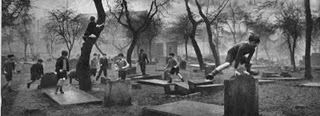
(picture) Corportation Burial ground in Rutherglen Road - The only bit of green in the Gorbals
Football takes on the proportion of a mythology, and players are seen as heroes of a fantasy world. In the bars and on the street corners you run into men with, you would think, small capacity for academic learning, but with such knowledge of the intricate history of professional footbal? as would earn them a professorship in any other field.
It used to be said "Every man has two capital dues—his own and Paris." In the Gorbals, everyman has two football teams—his own and Celtic. The local team is Clyde. But the dream team is the one with the green-and-white hoops. Inside Gorbals houses, the commonest pictures are of The Sacred Heart and the Celtic team. You see few likenesses of the Saints but many of Johnny Thomson, the Celtic goalkeeper, accidentally killed on September 5, 1931, in a game against the Rangers, and now spoken of reverently as a popular martyr and a bright hero brought down by misfortune.
(picture) Mrs Greenan of Commercial Road has bourne 13 children, lost 7 from pneumonia

In the past, writers have given the Gorbals a bad name, as an area for razor-toughs and meth-drinkers. This penny-dreadful picture has distracted the attention of liberal citizens from the real facts of life as they affect the district. It is not as the sensation-mongers pretend. Some criminals live there. So do some hunchbacks. The population is not composed of criminals, nor of hunchbacks.
Murder is rare in the district. Last August there were two cases in a single week. That was the year's quota. Organised crime, in the sense of gangs, hardly exists; though a while back a bunch of movie-inspired adolescents banded themselves into an outfit called the 'Hammer Gang,' and gave the police some trouble before they were broken up.
Assault is a frequent affair, especially wife assault. Razor fights are uncommon. If they do take place, it is generally with the old-fashioned cut-throat blade. Serious assaults, involving a number of assailants, occur from time to time, usually as part of some family feud. The use of the bayonet, is not unknown in the neighbourhood.
In his annual report, Glasgow's Chief Constable does not consider it politic to give a ward-by-ward breakdown of crime figures. But at 'A' Division's ' sub-station in Lawmoor Street, the cagey officer will tell you that the Gorbals is a pretty rough area, but that there are plenty of places just as rough elsewhere. The opinion of the bobby on the beat is that the sensationalist just don't know what they're writing about.
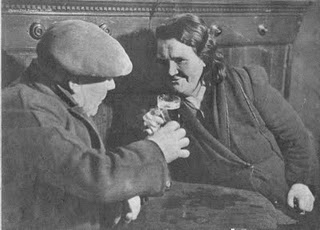
(picture) Recreation facilities are few in Gorbals. Pubs are plentiful. there are 174 of them (above Frank Judge's Bar) Some are good, some bad, all popular. but the idea that gorbals is peopled by roughnecked boozers is erroneous. The area is remarkble for kind, friendly folk, with a strong feeling for social justice.
After dark, the sky is red from the glow of Dixon's Ironworks, and even in bad weather the streets are full of folk who do not care to sit around in a crowded house whose evening breath is, as they say, like a lung-sick beast's. The district is a poor one for pleasure, though it contains the Citizens' Theatre, and an imposing set of 174 pubs, mostly of the pitch-pine and engraved-glass kind. Some of these are bold and bright, like Milarky's celebrated Horseshoe Bar in Crown Street. Some are sad and dismal, like the panhandlers' houses in Gorbals Street, where ' the habitual 'wine'-drinkers befuddle themselves with Red Biddy at is. 6d. a gill. Drunkenness, the old Glasgow trouble, is not sensational in the district. Of the 38 City wards, Gorbals comes sixth for the number of drunk-and-incapables apprehended over 12 months. With 122 arrests, she lags far be hind the less-populous districts of Calton (345) and Exchange (267). Drinkers of methylated spirits, surgical spirit and perfume are slightly on the increase just now, but (with 147 arrests in the whole city) they are four times fewer than they were in 1937.
Good-looking girls are numerous, and they wear their Marks and Spencer clothes with an air. Transparent macs and printed scarves are de rigueur. For the girls and their boy-friends there are two or three cinemas of varying dubiety, and Joe Diamond's Dancing Academy, a bright respectable place with a goodish if decorous band. There are also the railway arches. Living as they commonly do, huddled together with adults/often in the same bed, Gorbals youngsters find few mysteries among the facts of life. At the same time, the percentage of illegitimate births is not remarkably high (with 9.6 per cent. Gorbals' illegitimacy rate ranks sixth in the City). By and large, the youngsters have plenty of pride and few. illusions. Said one girl, "I hate it in the Gorbals. If I meet anyone new I have to give a false address." And another (with the words Biarritz, Quaglino's, Arc de Triomphe, Juan-les-Pins on her scarf) said, "We're eight in the one room. We go to bed in relays. My elder brothers walk round the court while we girls undress. Then they come back and kip down on their mattresses on the floor beside us. The cat sleeps with us. If a rat runs over the blankets, he springs out and has it."
At midnight, if you stand on any of the four bridges that run across the Clyde into the Gorbals, you see the windows still lit; for when the gas goes down, the rats come out in strength. So the lights bum dimly all night, and they shine on the huddled sleepers, on the delicate faces of the girls, and on the ravaged faces of the women who once were girls and on the men's faces that look like the broken slabs of every commandment in the decalogue.
(picture) Bright light for Gorbals youngsters is Saturday night at Diamond's Dance Hall (Academy) - They get no hard drinks; but the band is good
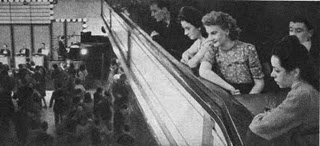
Here is our most loathsome slum, and a horror to be cleansed. Who owns it? Private people in London, Sydney, Shanghai and elsewhere. Factors (house-agents, they call them down South) own some tenements. Others belong to the Glasgow Corporation. Many were formerly the property of the L.M.S. Railway, and now presumably are the nation s affair. Sometimes the ownership is vague What is certain is that whoever owns the Gorbals precious little has been done, year by year, to case its hideous condition.
Let no one think the residents of the Gorbals like the way they live, or are apathetic to any agitation for change. They have an unusually deep awareness of their plight, and a hot anger for listless authority.
With Dundee, Gorbals was the first Scottish constituency to return a Labour member to Parliament That was in 1906. The vote has been solid for Labour ever since, because it is still believed that their lies the only hope for a change in local circumstance. Gorbals' present M.P. is Minister of Pensions, George Buchanan, recently raised to the dignity of Privy Councillor.
Perhaps because change is so slow to come, the local Communist Party is strong and well-received, and one of its leading members. Harry McShane, is something of a local hero on account of his fight for improved conditions. Nevertheless, partly from religious opposition, the Communist Party is not much voted for. The Gorbals and Hutchesontown Tenants Association (membership about 100) is active in canvassing the City Corporation for repairs to individual houses, but it carries rather less weight than the Gorbals Housing Campaign Committee, an organisation of combined political and professional men, started by the Rev. Bill Smith, a Church of Scotland minister, and Communist McShane, with the help of local doctors, lawyers and the like. Even so, the Glasgow Corporation—which has the greatest responsibility—is slow to move; and in the Gorbals the theory is widely held that 'the Corporation is no longer shockable.'
(picture) A young girl plays in the back-court of the gorbals. broken concrete, flooded pools, heaps pf smelling rubbish and rats
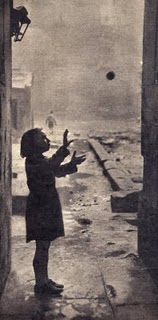
What could be done ? Most of the district was built up intentionally as a slum in the 1840's and i850's, and has so remained without change and almost without repair. The local folk say the area is ripe for dynamiting. Certainly nothing short of an over-all slum clearance would meet the case. The harassed Corporation has a proposed Fifty Years' Plan, under which they hope to re-develop most of the Gorbals for industrial purposes. The intention is to reduce the population density of that pan of the ward set aside for residence to 66 people to the acre.
To those who accuse them of apathy, the authorities point to the 850 slum houses that have been closed or demolished since 1920. In reply the impatient inhabitants point to the crumbling walls, the broken floors of the places they live in still. If ever there was a top priority—not only for the Glasgow City Corporation, but for the nation, too, if it values its self-respect—it is the destruction of the old Gorbals and the building of a better one.
A.L. Lloyd
Picture Post 31st January 1948
Pictures by Bert Hardy

